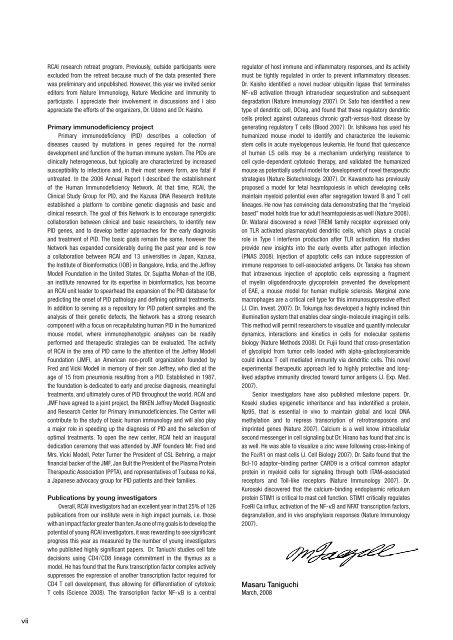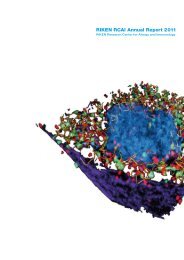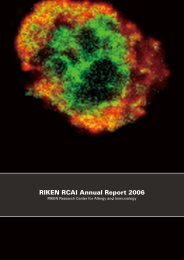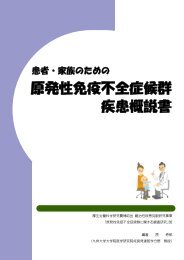in vivo
in vivo
in vivo
Create successful ePaper yourself
Turn your PDF publications into a flip-book with our unique Google optimized e-Paper software.
RCAI research retreat program. Previously, outside participants were<br />
excluded from the retreat because much of the data presented there<br />
was prelim<strong>in</strong>ary and unpublished. However, this year we <strong>in</strong>vited senior<br />
editors from Nature Immunology, Nature Medic<strong>in</strong>e and Immunity to<br />
participate. I appreciate their <strong>in</strong>volvement <strong>in</strong> discussions and I also<br />
appreciate the efforts of the organizers, Dr. Udono and Dr. Kaisho.<br />
Primary immunodeficiency project<br />
Primary immunodeficiency (PID) describes a collection of<br />
diseases caused by mutations <strong>in</strong> genes required for the normal<br />
development and function of the human immune system. The PIDs are<br />
cl<strong>in</strong>ically heterogeneous, but typically are characterized by <strong>in</strong>creased<br />
susceptibility to <strong>in</strong>fections and, <strong>in</strong> their most severe form, are fatal if<br />
untreated. In the 2006 Annual Report I described the establishment<br />
of the Human Immunodeficiency Network. At that time, RCAI, the<br />
Cl<strong>in</strong>ical Study Group for PID, and the Kazusa DNA Research Institute<br />
established a platform to comb<strong>in</strong>e genetic diagnosis and basic and<br />
cl<strong>in</strong>ical research. The goal of this Network is to encourage synergistic<br />
collaboration between cl<strong>in</strong>ical and basic researchers, to identify new<br />
PID genes, and to develop better approaches for the early diagnosis<br />
and treatment of PID. The basic goals rema<strong>in</strong> the same, however the<br />
Network has expanded considerably dur<strong>in</strong>g the past year and is now<br />
a collaboration between RCAI and 13 universities <strong>in</strong> Japan, Kazusa,<br />
the Institute of Bio<strong>in</strong>formatics (IOB) <strong>in</strong> Bangalore, India, and the Jeffrey<br />
Modell Foundation <strong>in</strong> the United States. Dr. Sujatha Mohan of the IOB,<br />
an <strong>in</strong>stitute renowned for its expertise <strong>in</strong> bio<strong>in</strong>formatics, has become<br />
an RCAI unit leader to spearhead the expansion of the PID database for<br />
predict<strong>in</strong>g the onset of PID pathology and def<strong>in</strong><strong>in</strong>g optimal treatments.<br />
In addition to serv<strong>in</strong>g as a repository for PID patient samples and the<br />
analysis of their genetic defects, the Network has a strong research<br />
component with a focus on recapitulat<strong>in</strong>g human PID <strong>in</strong> the humanized<br />
mouse model, where immunophenotypic analyses can be readily<br />
performed and therapeutic strategies can be evaluated. The activity<br />
of RCAI <strong>in</strong> the area of PID came to the attention of the Jeffrey Modell<br />
Foundation (JMF), an American non-profit organization founded by<br />
Fred and Vicki Modell <strong>in</strong> memory of their son Jeffrey, who died at the<br />
age of 15 from pneumonia result<strong>in</strong>g from a PID. Established <strong>in</strong> 1987,<br />
the foundation is dedicated to early and precise diagnosis, mean<strong>in</strong>gful<br />
treatments, and ultimately cures of PID throughout the world. RCAI and<br />
JMF have agreed to a jo<strong>in</strong>t project, the RIKEN Jeffrey Modell Diagnostic<br />
and Research Center for Primary Immunodeficiencies. The Center will<br />
contribute to the study of basic human immunology and will also play<br />
a major role <strong>in</strong> speed<strong>in</strong>g up the diagnosis of PID and the selection of<br />
optimal treatments. To open the new center, RCAI held an <strong>in</strong>augural<br />
dedication ceremony that was attended by JMF founders Mr. Fred and<br />
Mrs. Vicki Modell, Peter Turner the President of CSL Behr<strong>in</strong>g, a major<br />
f<strong>in</strong>ancial backer of the JMF, Jan Bult the President of the Plasma Prote<strong>in</strong><br />
Therapeutic Association (PPTA), and representatives of Tsubasa no Kai,<br />
a Japanese advocacy group for PID patients and their families.<br />
Publications by young <strong>in</strong>vestigators<br />
Overall, RCAI <strong>in</strong>vestigators had an excellent year <strong>in</strong> that 25% of 126<br />
publications from our <strong>in</strong>stitute were <strong>in</strong> high impact journals, i.e. those<br />
with an impact factor greater than ten. As one of my goals is to develop the<br />
potential of young RCAI <strong>in</strong>vestigators, it was reward<strong>in</strong>g to see significant<br />
progress this year as measured by the number of young <strong>in</strong>vestigators<br />
who published highly significant papers. Dr. Taniuchi studies cell fate<br />
decisions us<strong>in</strong>g CD4/CD8 l<strong>in</strong>eage commitment <strong>in</strong> the thymus as a<br />
model. He has found that the Runx transcription factor complex actively<br />
suppresses the expression of another transcription factor required for<br />
CD4 T cell development, thus allow<strong>in</strong>g for differentiation of cytotoxic<br />
T cells (Science 2008). The transcription factor NF-κB is a central<br />
regulator of host immune and <strong>in</strong>flammatory responses, and its activity<br />
must be tightly regulated <strong>in</strong> order to prevent <strong>in</strong>flammatory diseases.<br />
Dr. Kaisho identified a novel nuclear ubiquit<strong>in</strong> ligase that term<strong>in</strong>ates<br />
NF-κB activation through <strong>in</strong>tranuclear sequestration and subsequent<br />
degradation (Nature Immunology 2007). Dr. Sato has identified a new<br />
type of dendritic cell, DCreg, and found that these regulatory dendritic<br />
cells protect aga<strong>in</strong>st cutaneous chronic graft-versus-host disease by<br />
generat<strong>in</strong>g regulatory T cells (Blood 2007). Dr. Ishikawa has used his<br />
humanized mouse model to identify and characterize the leukemic<br />
stem cells <strong>in</strong> acute myelogenous leukemia. He found that quiescence<br />
of human LS cells may be a mechanism underly<strong>in</strong>g resistance to<br />
cell cycle-dependent cytotoxic therapy, and validated the humanized<br />
mouse as potentially useful model for development of novel therapeutic<br />
strategies (Nature Biotechnology. 2007). Dr. Kawamoto has previously<br />
proposed a model for fetal heamtopoiesis <strong>in</strong> which develop<strong>in</strong>g cells<br />
ma<strong>in</strong>ta<strong>in</strong> myeloid potential even after segregation toward B and T cell<br />
l<strong>in</strong>eages. He now has conv<strong>in</strong>c<strong>in</strong>g data demonstrat<strong>in</strong>g that the “myeloid<br />
based” model holds true for adult heamtopoiesis as well (Nature 2008).<br />
Dr. Watarai discovered a novel TREM family receptor expressed only<br />
on TLR activated plasmacytoid dendritic cells, which plays a crucial<br />
role <strong>in</strong> Type I <strong>in</strong>terferon production after TLR activation. His studies<br />
provide new <strong>in</strong>sights <strong>in</strong>to the early events after pathogen <strong>in</strong>fection<br />
(PNAS 2008). Injection of apoptotic cells can <strong>in</strong>duce suppression of<br />
immune responses to cell-associated antigens. Dr. Tanaka has shown<br />
that <strong>in</strong>travenous <strong>in</strong>jection of apoptotic cells express<strong>in</strong>g a fragment<br />
of myel<strong>in</strong> oligodendrocyte glycoprote<strong>in</strong> prevented the development<br />
of EAE, a mouse model for human multiple sclerosis. Marg<strong>in</strong>al zone<br />
macrophages are a critical cell type for this immunosuppressive effect<br />
(J. Cl<strong>in</strong>. Invest. 2007). Dr. Tokunga has developed a highly <strong>in</strong>cl<strong>in</strong>ed th<strong>in</strong><br />
illum<strong>in</strong>ation system that enables clear s<strong>in</strong>gle-molecule imag<strong>in</strong>g <strong>in</strong> cells.<br />
This method will permit researchers to visualize and quantify molecular<br />
dynamics, <strong>in</strong>teractions and k<strong>in</strong>etics <strong>in</strong> cells for molecular systems<br />
biology (Nature Methods 2008). Dr. Fujii found that cross-presentation<br />
of glycolipid from tumor cells loaded with alpha-galactosylceramide<br />
could <strong>in</strong>duce T cell mediated immunity via dendritic cells. This novel<br />
experimental therapeutic approach led to highly protective and longlived<br />
adaptive immunity directed toward tumor antigens (J. Exp. Med.<br />
2007).<br />
Senior <strong>in</strong>vestigators have also published milestone papers. Dr.<br />
Koseki studies epigenetic <strong>in</strong>heritance and has <strong>in</strong>dentified a prote<strong>in</strong>,<br />
Np95, that is essential <strong>in</strong> <strong>vivo</strong> to ma<strong>in</strong>ta<strong>in</strong> global and local DNA<br />
methylation and to repress transcription of retrotransposons and<br />
impr<strong>in</strong>ted genes (Nature 2007). Calcium is a well know <strong>in</strong>tracellular<br />
second messenger <strong>in</strong> cell signal<strong>in</strong>g but Dr. Hirano has found that z<strong>in</strong>c is<br />
as well. He was able to visualize a z<strong>in</strong>c wave follow<strong>in</strong>g cross-l<strong>in</strong>k<strong>in</strong>g of<br />
the FcεR1 on mast cells (J. Cell Biology 2007). Dr. Saito found that the<br />
Bcl-10 adaptor–b<strong>in</strong>d<strong>in</strong>g partner CARD9 is a critical common adaptor<br />
prote<strong>in</strong> <strong>in</strong> myeloid cells for signal<strong>in</strong>g through both ITAM-associated<br />
receptors and Toll-like receptors (Nature Immunology 2007). Dr.<br />
Kurosaki discovered that the calcium-b<strong>in</strong>d<strong>in</strong>g endoplasmic reticulum<br />
prote<strong>in</strong> STIM1 is critical to mast cell function. STIM1 critically regulates<br />
FceRI Ca <strong>in</strong>flux, activation of the NF-κB and NFAT transcription factors,<br />
degranulation, and <strong>in</strong> <strong>vivo</strong> anaphylaxis responses (Nature Immunology<br />
2007).<br />
Masaru Taniguchi<br />
March, 2008<br />
vii





